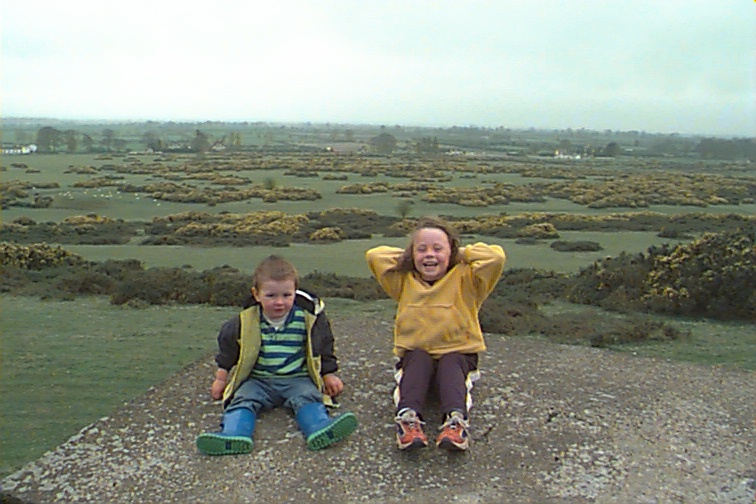|
The Curragh is perhaps the oldest and most extensive tract of
semi-natural grassland in Europe, having existed as such for over two thousand years. It
is possible the only landscape of its kind in the world consisting of a mainly unenclosed
flat to gentle rolling plain of 4,870 acres. Following the the treaty of 1921, the lands
passed from the Crown to the Minister for Finance and later to
the Minister for Defence and is administered by his Department's property Management Branch under the Curragh of Kildare Acts. |
|
The Curragh has a
number of sensitive archaeological sites and rare grass species all of which are the
subject of frequent studies by students from various Universities and Colleges. Those of
note include the Gibbet Rath, and base of the cross at Rathbride and the ancient road
known as the Race of the Black Pig. The archaeological sites have been listed by the
National Monuments Branch of the Office of Public Works (OPW). Maps and schedules are
available at the County Library. |

|
|
Tradition
has it that the great plain was handed over to St. Brigid of Kildare in the year 480 AD.
The Curragh is closely related to many neighbouring historical sites. To the south is Dun
Ailainne, a national monument dating back to 300 BC and the seat of the Kings of Leinster.
To the north, is the Hill of Allen where, it is claimed, Fionn Mac Cumhaill and the Fianna
assembled. The Curragh has been the scene of horse racing for hundreds of years and golf
was first played on the Curragh in 1852. |
|

|
Early
management of the Curragh by the Crown was through the Office of the Ranger. Through this
office the Crown set about preserving the Curragh, against the depredations of trespassers
and encroachers, either horsemen, grazers or vagrants. This office can be traced back
pre-1680 and the office was to last until 1961 and was abolished by the Curragh of Kildare
Act 1961. Historical records confirm that the Curragh survived more or less intact
throughout that period of time.
The
formal statutory basis for the Ranger had to await the passing of the Curragh of Kildare
Act of 1868 when the post came under the direction of the Lord Lieutenant. |
|
The
Office of Ranger was vacant from 1904 to 1910 due to a dispute with the War Office. The
War Office at that time wished to take control of the Curragh and have the office and
function of the Ranger abolished. This challenge was resisted and eventually, the
Government overruled the Military, restored the Rangership and appointed George Wolfe, of
Forenaughts, Naas. George Wolf held this office until his death in 1941 and during this
period, also found member of Cumann na nGaedhael and TD for Co. Kildare. George Wolf had
the distinction of being the last Ranger appointed by the British. For the next 20 years
the post was filled by the Chairman of the OPW by appointment on behalf of the Minister
for Finance. |
|
|
The Curragh has been the subject of legislation as far
back as 1299, when an Act was passed, to prevent swine feeding on the Curragh plains to
the detriment of the sward. However, it was to be the Acts of 1868 and 1870 that were to
govern the Curragh for over 100 years. In response to agitation, the House of parliament
set up a Commission in 1865 to examine the Curragh. The findings of the 1865 Commission
led to the enactment of the Curragh of Kildare Act 1868. This was described as an
Act to make better provision for the management and use of the Curragh of Kildare,
ascertaining and preserving the use of the Curragh for the purpose of horse racing and the
training of racehorses. The care, management and the preservation of the Curragh was
vested in the Ranger, a nominal and honorary position with no salary attached.
The
total area under the 1868 Act was defined as 4,870 acres and divided into 3 parts:
Brown
Lands (site of camp)....575 acres
Blue Lands (rifle ground)........463 acres
Green Lands (residue)............3,382 acres |
The
Lord Lieutenant of Ireland with the advice of the Privy Council on December 3, 1868,
issued bye-laws for the purpose of managing the Curragh more efficiently. These bye-laws
lasted until 1964. The Curragh of Kildare Act of 1868 provided for a second Commission to
inquire in to the position of the rights of common pasture and they reported in June 1869.
Their report is embodied in the Curragh of Kildare Act 1870. In all 7,957 sheep grazing
rights were approved as being appurtenant to holdings adjacent to the Curragh on the basis
of approximately one right to each acre (Irish Plantation) of such holdings, while
in some cases claims were refused and no awards made. The sheep claims were listed in the
first schedule, with the use of right of ways and public roads in second schedule. The
Commissioners disallowed many claims but there was not a single appeal despite procedures
being provided for in the 1868 Act. The Curragh of Kildare Act 1870 confirmed the award of
second Commissioners (1869) and in addition specified that only sheep could be grazed on
the Curragh.
The
Curragh of Kildare Act 1961 repealed the 1868 Act and parts 4, 5 and 6 of the 1870 Act. A
total of 196 acres was added to the Brown Lands and 352 acres to the Blue Lands resulting
in the reduction of the Green Lands by 548 acres. While the total area remained at 4,870
acres the Act deemed that the Curragh be divided into:
Brown
Lands........771 acres
Blue Lands...........815 acres
Green Lands........3,284 acres |
|
One of the most
important provisions of the 1961 Act is that which deals with the enclosures and the
voluntary surrender and extinguishment of grazing rights. At the time of the passing of
the Act, the number of sheep rights stood at 7,957 which was somewhat less than twice the
number as were the acres available for grazing. The 1961 Act abolished the office of
Ranger with the management duties of that office transferring to the Department of
Defence. Today the Department employs a staff of four full time civilian employees at the
Curragh to look after the day-to-day affairs of the Blue and Green lands. |

|
|
Further
legal recognition of the Curragh was brought about by the introduction of bye-laws by the
Minister for Defence on January 15, 1964. These bye-laws provided for further regulation
of the use and management of the Curragh. The 1969 Act amended and extended the Curragh of
Kildare Act 1961. The important sections being 2 and 3 which put on the statute book
provisions which up to then had only the status of bye-laws. Section 4 and 5 provided for
means to deal with the contravention of the law, effective control of sheep grazing on the
Curragh and those entitled to graze. This act changed the titles of the Department of
Defence employees on the Curragh from Head Bailiff and Bailiff to Maor and Fo-Mhaor. |
| |
|
|
Apart from its support to the bloodstock industry the provision
of grazing for 6,000 breeding ewes annually makes the Curragh a major contributor to the
agricultural economy. The area is also used extensively by the military for training and
there is increasing public demand for amenity facilities. The Department of Defence makes available lands at the Curragh for various sporting
activities. In 1994, the Curragh played a major part in attracting the 'Braveheart' film
project to Ireland and the lands were used extensively during the filming. |
|
|
|

|
Our predecessors, despite living in turbulent times of wars,
plantations and the famine, took what ever steps were necessary to maintain the Curragh in
its original state. The value and importance of this unique property can never be
overstressed and places heavy responsibility on the Department of Defence to ensure its conservation.
|
|